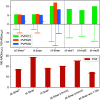COSMOPharm: Drug-Polymer Compatibility of Pharmaceutical Amorphous Solid Dispersions from COSMO-SAC
- PMID: 39078049
- PMCID: PMC11372840
- DOI: 10.1021/acs.molpharmaceut.4c00342
COSMOPharm: Drug-Polymer Compatibility of Pharmaceutical Amorphous Solid Dispersions from COSMO-SAC
Abstract
The quantum mechanics-aided COSMO-SAC activity coefficient model is applied and systematically examined for predicting the thermodynamic compatibility of drugs and polymers. The drug-polymer compatibility is a key aspect in the rational selection of optimal polymeric carriers for pharmaceutical amorphous solid dispersions (ASD) that enhance drug bioavailability. The drug-polymer compatibility is evaluated in terms of both solubility and miscibility, calculated using standard thermodynamic equilibrium relations based on the activity coefficients predicted by COSMO-SAC. As inherent to COSMO-SAC, our approach relies only on quantum-mechanically derived σ-profiles of the considered molecular species and involves no parameter fitting to experimental data. All σ-profiles used were determined in this work, with those of the polymers being derived from their shorter oligomers by replicating the properties of their central monomer unit(s). Quantitatively, COSMO-SAC achieved an overall average absolute deviation of 13% in weight fraction drug solubility predictions compared to experimental data. Qualitatively, COSMO-SAC correctly categorized different polymer types in terms of their compatibility with drugs and provided meaningful estimations of the amorphous-amorphous phase separation. Furthermore, we analyzed the sensitivity of the COSMO-SAC results for ASD to different model configurations and σ-profiles of polymers. In general, while the free volume and dispersion terms exerted a limited effect on predictions, the structures of oligomers used to produce σ-profiles of polymers appeared to be more important, especially in the case of strongly interacting polymers. Explanations for these observations are provided. COSMO-SAC proved to be an efficient method for compatibility prediction and polymer screening in ASD, particularly in terms of its performance-cost ratio, as it relies only on first-principles calculations for the considered molecular species. The open-source nature of both COSMO-SAC and the Python-based tool COSMOPharm, developed in this work for predicting the API-polymer thermodynamic compatibility, invites interested readers to explore and utilize this method for further research or assistance in the design of pharmaceutical formulations.
Keywords: COSMO-SAC; amorphous solid dispersions (ASD); drug−polymer thermodynamic compatibility; miscibility; prediction; quantum mechanics; solubility.
Conflict of interest statement
The authors declare no competing financial interest.
Figures










Similar articles
-
Can Pure Predictions of Activity Coefficients from PC-SAFT Assist Drug-Polymer Compatibility Screening?Mol Pharm. 2023 Aug 7;20(8):3960-3974. doi: 10.1021/acs.molpharmaceut.3c00124. Epub 2023 Jun 29. Mol Pharm. 2023. PMID: 37386723 Free PMC article.
-
Drug-polymer compatibility prediction via COSMO-RS.Int J Pharm. 2024 Oct 25;664:124613. doi: 10.1016/j.ijpharm.2024.124613. Epub 2024 Aug 22. Int J Pharm. 2024. PMID: 39179010
-
Navigating the Solution to Drug Formulation Problems at Research and Development Stages by Amorphous Solid Dispersion Technology.Recent Adv Drug Deliv Formul. 2024;18(2):79-99. doi: 10.2174/0126673878271641231201065151. Recent Adv Drug Deliv Formul. 2024. PMID: 38062659 Review.
-
Predicting Drug-Polymer Compatibility in Amorphous Solid Dispersions by MD Simulation: On the Trap of Solvation Free Energies.Mol Pharm. 2025 Feb 3;22(2):760-770. doi: 10.1021/acs.molpharmaceut.4c00810. Epub 2024 Nov 25. Mol Pharm. 2025. PMID: 39585959
-
Analytical and Computational Methods for the Determination of Drug-Polymer Solubility and Miscibility.Mol Pharm. 2021 Aug 2;18(8):2835-2866. doi: 10.1021/acs.molpharmaceut.1c00141. Epub 2021 May 27. Mol Pharm. 2021. PMID: 34041914 Review.
Cited by
-
Extraction of Chlorogenic Acid Using Single and Mixed Solvents.Molecules. 2025 Jan 22;30(3):481. doi: 10.3390/molecules30030481. Molecules. 2025. PMID: 39942586 Free PMC article.
References
-
- Davis D. A.; Thakkar R.; Maniruzzaman M.; Miller D. A.; Williams R. O. In Formulating Poorly Water Soluble Drugs; Williams R. O., Davis D. A., Miller D. A., Eds.; Springer: Cham, 2022.
MeSH terms
Substances
LinkOut - more resources
Full Text Sources
Research Materials

